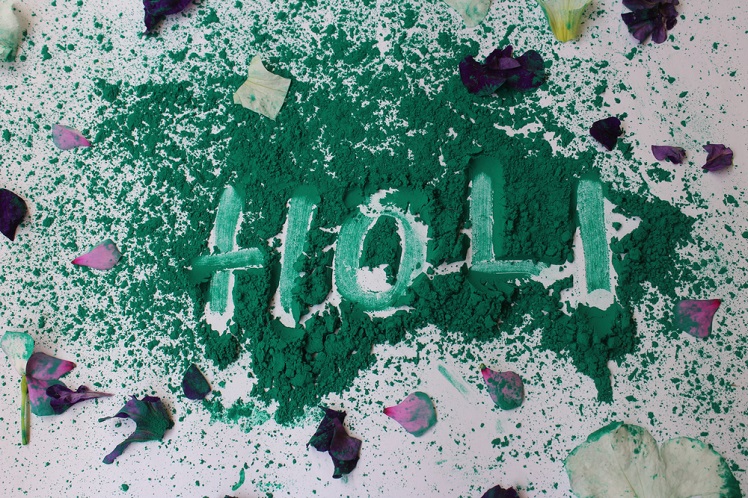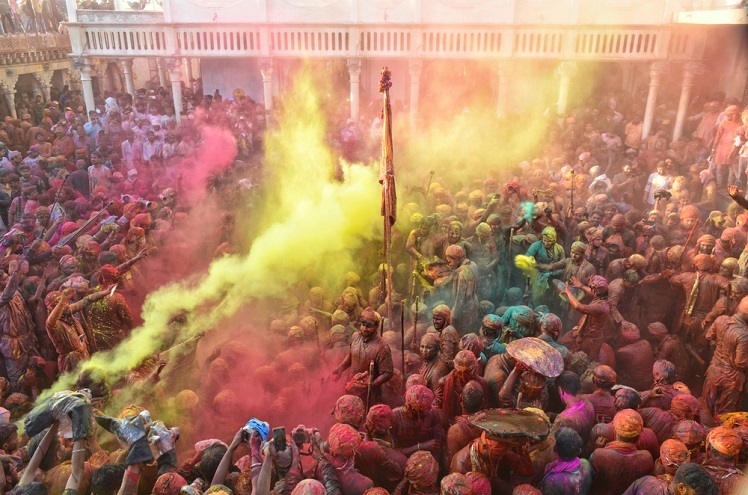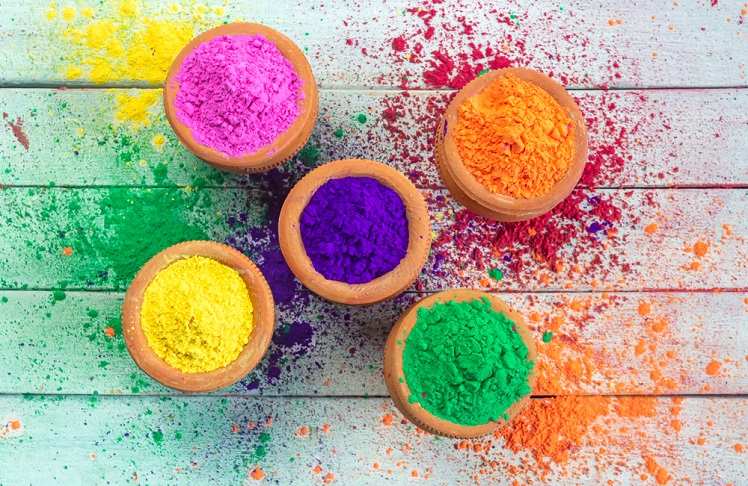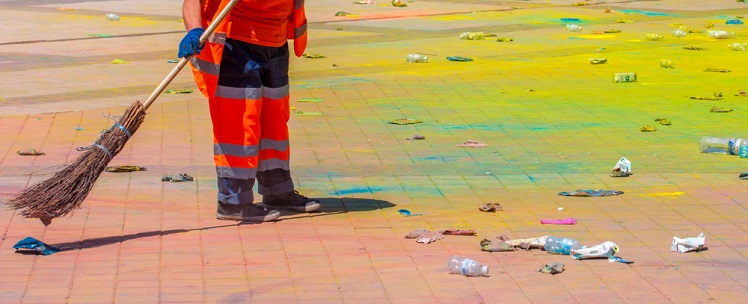We are sure you are probably familiar with this fun, exciting festival that brings so much joy to people who celebrate it. But for those who never heard about it, let us give you a sneak peek before we rush to talk about eco-friendly Holi! Holi is basically a Hindu festival in India to get rid of bad vibes and lit up only the good triumph. No wonder people around the world now also follow and enjoy this celebration.
Usually, they will throw a bunch of colorful powders at one another as a symbol of great happiness while forgetting about rough life for a while. Unfortunately, it has a massive cost to our environment after this excitement ends. Reckless people, particularly, will litter the plastics everywhere after they are festive.
Not to mention the artificial colorants that will be flushed away with water and flowing to the ditches around will pollute the river and sea! What an unfortunate situation, as you feel the bliss while choking the river and marine life at the same time. Hence, it is crucial to find a way to enjoy the Holi in a more environmentally friendly way. So, let’s discuss it!
Table of Contents
Which Chemical Is Used In Holi?
Harmful chemicals are usually added to dyes for the Holi festival. Despite some being aware of it and moving to safer options (natural dyes), others still use synthetic ones. The reason is simple: the chemical colors are more eye-catching. Thus, producing striking colors that seem more festive.

People don’t realize the bad impact of using those colorants on the environment and health. Some of the materials used to make those dyes are:
1. Copper Sulfate
This chemical is usually contained in the green colorant, particularly the paste one. It gives you a cheerful green color, but wait for the adverse effects. Your skin will start feeling a burning and itching sensation, followed by eye allergy if they are exposed to your eyes. And worse, temporary blindness may happen in case they get to your eyes in large quantities.
2. Prussian Blue
Just like its name, Prussian blue displays vibrant blue to the color-paste people usually use to celebrate Holi. Sadly, exposure to this chemical has the risk of causing irritation or dermatitis on the skin. It may also cause tearing or red eyes.
3. Lead Oxide
Some people include black color in the Holi celebration. Unfortunately, some black paste contains lead oxides, which harm human health. Its low exposure can cause irritation to your skin, headache, and stomach upset. And if you inhale the chemical too much, it may lead to renal failure.
4. Mercury Sulfide
It is almost impossible to not add red color to the list of dyes for Holi. Frankly, some synthetic red colorants contain mercury sulfide, which can cause blisters, burning sensations, itching, and pain on your skin. When ingested, the effect will be even worse, such as vomiting, diarrhea, and collapse.
5. Chromium
This toxic chemical is often found in gulal or dry colors commonly used during the Holi. Exposure to such substances causes headaches, allergic reactions, and bronchial asthma. If it’s too severe, it can even lead to kidney damage.
Why is Holi Eco-Friendly?
Holi festivals generally use paste, water, or synthetic dry dyes with striking colors. However, it is the after-party that causes a lot of problems, especially the environment. Plastic garbage is scattered, while the colorants pollute the soil and water.
Not to mention the color dust, which may pose a risk of interfering with breathing. Given its impact on the environment, it is essential to consider finding ways to celebrate a festival full of happiness but harmful to our Earth.

So, let’s talk further about the definition of eco-friendly Holi and the disadvantages of celebrating the festival without considering the environmental impacts.
1. Eco-Friendly Holi
You can enjoy the excitement of the Holi festival while protecting our planet by switching to eco-friendly Holi. Eco-friendly Holi is basically the same festival as the non-eco one. It’s just that it uses the environmental principle by using environmentally friendly stuff. Some examples are replacing synthetic dyes with organic ones, using non-plastic bags, and reducing water use.
2. What’s Holi Powder Made of?
There are two types of Holi powders, synthetic and natural dyes. Artificial colorants are usually made from chemicals, such as copper sulfate (green), chromium iodide (purple), lead oxide (black), mercury sulfide (red) and powdery glass (shiny colors). These chemicals are toxic. In addition, there are cases where 200 people were rushed to the hospital, and one died due to dye poisoning.
On the flip side, the natural ones are safe to use and do not pose health risks for humans and animals. They also do not expose adverse environmental effects because they are made from natural ingredients, such as turmeric, pandan leaves, and hibiscus.
3. What Are The Disadvantages Of Holi Without Eco-Friendly Products?
Unlike eco-friendly products that bring many benefits to the environment, the celebration of Holi without those eco-friendly items has many dire consequences. Some of them are:
- Water, soil, and air pollution due to the chemical dyes used cannot be easily degraded and treated.
- In addition to pollution, synthetic colorants are also potentially harmful to health. Symptoms that arise due to exposure to toxic chemicals are irritation, itching, burning sensation, red eyes, shortness of breath, and fainting. In some rare cases, it can even lead to death.
- The increase in plastic waste from water balloons thrown around enlivened the festival. People usually bring bottled water to wash their bodies off the dyes.
- And for side notes, this festival also consumes a lot of water. An average person will use 30 liters of water to wash off the dye on his body. Especially if they use chemical dyes, which are more difficult to clean.
How To Make Holi Festivals More Environmentally Friendly?
One of the major festivals of India, Holi, is celebrated across the country with enthusiasm and excitement. It is all about fun and painting the country in vibrant colors. With that being said, let’s celebrate eco-friendly Holi this year, using eco-friendly products so that the festival is not only brightened with colors but it is also environmentally friendly!

Here are some of the tips on how to celebrate Holi in the most eco-friendly way:
1. Switch To Homemade Colors
Color is the most important tool of the festival. It is celebrated by using synthetic colors that are not only filled with chemicals but are also expensive and could even cause skin problems and allergies.
So, switch to homemade colors. It is simple to make colors out of turmeric, pandan, hibiscus, henna and sandalwood. By mixing these together with corn starch; you can make natural colors to play Holi. The best part, the color stain is gone once you wash it off!
2. Put Down The Water Usage
There are many parts of the country where people face water scarcity. People have to walk for miles to fetch clean water to drink. So, using less water will help in conserving this essential life-sustenance element. Measure the water first and pour it into your reusable bottle.
Let us take a step towards conserving this natural resource by preventing its wastage and avoid using water balloons to keep the streets garbage free.

3. Plastic Bags! STOP USING IT!
Plastic causes toxic risks to human health from its use to disposal and even beyond that. So, to protect the environment from plastic toxicity, use biodegradable products. If put down in simpler words, use eco-friendly bags to protect our environment from the plastic wastes and its consequences.
During this festival, drinks are served to keep the body hydrated from the spring heat! Instead of using plastic cups and plastic straws, switch to eco-friendly straws and eco-friendly cups.
Some of the biodegradable products to make your Holi eco-friendly are made from PLA (Poly Lactic Acid), CPLA (Crystallized Poly Lactic Acid), cornstarch and cassava. Below are some of the revolutionary product details to make your Holi eco-friendly:
Cassava Grip Hole Bags
This classic eco-friendly bag is a substitute for plastic bags and a great way to protect the environment from plastic toxicity. You can use this bag to carry the colors, extra pair of clothes and food also while you’re at a Holi event.
CPLA Spoon, Knife and Fork
Get CPLA based eco-friendly cutlery and take a step towards saving the planet. This cutlery can be used while eating the food served.
Cornstarch Based Round Bowl
Another biodegradable product, round bowl, is made out of cornstarch. Get these environmentally friendly bowls instead of harmful plastic bowls. These bowls can be used for serving pakoras, snacks and also special sweets made for Holi.
PLA Straws
Savor your cool beverage with biodegradable straws made from PLA as it protects the environment from disposing of plastic wastes. You can use these straws with the drinks served at the Holi event. These are some of the ways you can celebrate an eco-friendly and safe Holi by going all-natural and using biodegradable products. Wishing you a very Happy Holi!
Use of these eco-friendly products will make you not only a responsible individual but also someone who is stepping towards bringing a positive change in the world.
How Does Eco-Friendly Holi Affect The Environment?
In contrast to the usual Holi celebration, which has a long-term effect on environmental damage, the eco-friendly Holi actually helps you enjoy this festival’s joy while contributing to keeping the Earth happy!
The use of non-plastic bags will reduce plastic waste sent to landfill. Thus, protecting our coastal ecosystem from the microplastics whose impact is already being felt by humans. Studies show that about 68% of fish in Fiji are contaminated with microplastics. In addition, another report found that the organ of each fishmeal-relevant species contains 0.72 microplastics per individual. And you know where the fish will go? Consumed by us humans.

Meanwhile, using natural colorants to replace synthetics has a major impact on the environment, especially soil and water. Those dyes are made from natural ingredients easily degraded by soil microbes. Thus, you don’t have to worry about groundwater pollution. They are also safe when flowing into rivers or ditches because no toxic materials harm aquatic life.
Final Thoughts
While we enjoy a joyful religious celebration, such as Holi, we should not ignore its impact on the environment. You can change the dyes with natural ones, cut the water use, and say bye to plastic bags. By switching to eco-friendly Holi, you can contribute to save our planet from further damage. And of course provides an opportunity for our future generation to witness the beauty of our mother Earth.
Latest Post:
- Bioplastic Pros and Cons: An Unbiased Examination
- Eco-Friendly Bottling: Aluminum as the Sustainable Hero?
- How to Make Bioplastic from Rice: A Step-by-Step Guide
- Eco-Tips: How to Recycle Amazon Envelopes?
- What Does Compostable Mean?
FAQ (Frequently Asked Questions)
Is Holi powder eco-friendly?
Although it is a fun festival that allows people to feel the excitement in the air, it also shows a bitter fact that the powder is not eco-friendly. Holi festivals generally use synthetic dyes. They mostly contain extremely carcinogenic compounds, such as rhodamine, malachite green, and auramine. Of course, they are harmful to our environment because they have the potential to pollute waters and soil. Not only that, those toxic chemicals are detrimental to human and animal health.
How do the chemicals in Holi colors cause water pollution?
The dyes used during the Holi festival are mostly loaded with carcinogenic substances. Unlike natural colors, they are not degradable. Thus, water waste treatment sadly cannot treat them. And for that reason, the chemicals are at risk of polluting the environment, including water. Especially if they are doused with water or flowing because of the rain into the surrounding ditches. You know they’re going to end up in the ocean, right?
How do you make organic colors?
You can easily make your own DIY organic colors, for example: for the yellow shade, mix turmeric powder and flour with a ratio of 2:1. After that, sieve it to make the powder softener. Besides yellow, you can make red by mixing turmeric with lemon juice, which will turn the yellow into red! Then, dry them and make sure not to expose them to the sun.
Now, you can add them to flour and mix! How about the greens? If you have pandan leaves, chop and dry them. Next, blend until smooth and mix in flour.
Is water wasted in Holi?
You will be shocked if we tell you that every person celebrating Holi spends about 2 buckets of water. Or the equivalent of 30 liters of water! To cut the water use, you can use natural colorants, which are easier to wash off. Also, avoid playing with water balloons that have too much water. It is better to measure the amount of water you will bring to the festival, so you don’t waste too much.
Why is natural color good for playing Holi?
Natural dyes are way better than synthetic colorants in terms of their friendliness to the environment. True to its name, natural ones are generally made of turmeric, beets, pandan leaves, hibiscus, and corn starch, all the ingredients that won’t pollute the earth. They are easy to degrade. Thus, color waste is easy to treat. In addition, these natural colors are also easy to clean. Hence, you will not waste too much water.
